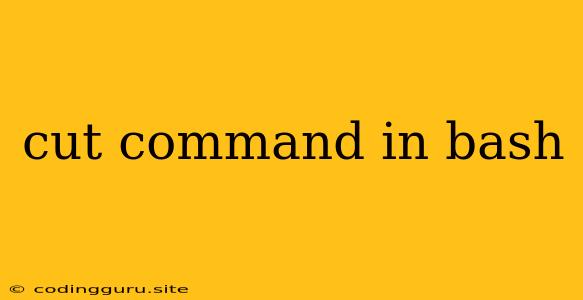The cut command is a powerful tool in the Bash shell for extracting specific portions of text. Whether you need to isolate columns from a CSV file, extract specific characters from a string, or manipulate text in various ways, cut provides the flexibility to achieve your desired results.
Understanding the Fundamentals
At its core, cut operates on lines of text, targeting specific characters or fields (delimited by specific characters) within those lines. Let's break down the key concepts:
1. Delimiters:
cutuses delimiters to identify boundaries between fields. Common delimiters include:- -d: Specifies the delimiter character, which is usually a space, comma, tab, or other special character.
- -f: Indicates the field number or range of fields to extract.
2. Characters:
cutcan also work with specific characters within a line.- -c: Used to extract a range of characters based on their position.
Practical Examples
Here are some practical examples to illustrate how cut works:
1. Extracting Columns from a CSV File:
cut -d',' -f2,4 data.csv
- This command extracts the second and fourth columns from a CSV file named
data.csv. - The delimiter is a comma (
,). - The
-f2,4specifies the fields to extract.
2. Isolating Characters from a String:
echo "Hello, World!" | cut -c 7-12
- This command extracts characters from position 7 to 12 (inclusive) from the string "Hello, World!".
- The output will be "World!".
3. Handling Different Delimiters:
cut -d':' -f2 /etc/passwd
- The
cutcommand is used to extract the second field of/etc/passwdfile, which contains user information. - The colon (
:) is the delimiter for fields in the/etc/passwdfile.
4. Combining Multiple Options:
cut -d' ' -f3- /etc/passwd | cut -d':' -f1
- This command demonstrates the combination of multiple
cutoperations. - It first extracts fields from the third field onwards, delimited by space, from the
/etc/passwdfile. - Then, it uses a second
cutcommand to extract the first field, delimited by colon (:) from the result. - This effectively isolates the user's username from the
/etc/passwdfile.
Tips and Tricks
- Handling Multiple Delimiters: You can use the
-soption to suppress output if a line doesn't have the specified number of fields. - Combining with other commands:
cutcan be used in conjunction with other Bash commands such asgrep,sort,head, andtailto further refine your data manipulation. - Understanding Field Numbers: Remember that the
-foption refers to the position of a field within a line, starting from 1.
Conclusion
The cut command is a versatile tool in Bash for extracting specific portions of text. Its ability to work with delimiters, characters, and various options makes it a valuable asset for text manipulation and data processing. Understanding its fundamentals and exploring different use cases will empower you to effectively utilize this command for a wide range of tasks. By practicing with these examples and incorporating cut into your Bash scripts, you can streamline your data analysis and text processing efforts.
